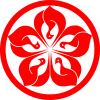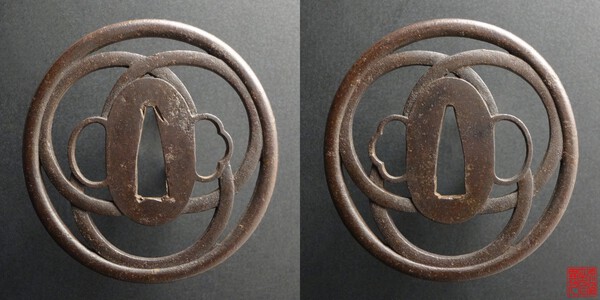-
Posts
515 -
Joined
-
Last visited
-
Days Won
5
Content Type
Profiles
Forums
Events
Store
Downloads
Gallery
Everything posted by zanilu
-
Dear all I would like to have your opinion on my most recent acquisition. It is 83.5 mm x 78.6 mm, thickness at seppa dai 3 mm, at mimi 4.1 mm. It has hira zogan of brass and silver. From the shape, distribution of thickness, the quality of the mixed hira zogan, the quality and color of the iron I am inclined to attribute it to Washida shcool rather than Heinajo zogan or Kaga Yoshiro. What is your take? Regards Luca
-
Bells are are cast and ring as bells! I have personally cast iron pieces at high school in my time and they ting as bells when hit. My two cents... Regards Luca
-
Just personal considerations Vitaly. Submitted to the NMB to have opinion from other collectors... Regards Luca
-
I have recently acquired a new NBTHK papered Kaga Yoshiro tsuba: This is, to me at least, an interesting piece on several aspects. First, the meaning of the sukashi decoration. There is a suhama gata with something that looks like leaves or a plant of some kind. Maybe this is somewhat related to those composition representing island or shores. For example from https://www.aisf.or.jp/~jaanus/deta/s/suhamagata.htm: "Also suhama 州浜. A shape made up of three rings. Used in garden design and landscape paintings. An imitation of a sandy beach. Usually the shape is twisted or elongated to create an original variation." If any of you has a different interpretation or, if I am spot on (that I really doubt), can you help to better describe the desing? Second, this is the first papered, Kaga Yoshiro tsuba with ji-sukashi outside of the brass inlayed roundels, that I have seen. If not for the two, rather small brass inlayed mons I would have been inclined to a Heianjo zogan attribution due to the lack of any egraved line shadowing the karakusa inlay, typical of kamon Yoshiro tsuba. Also the sen zogan is not usually found on Yoshiro pieces. Third, there is a lot of remaining lacquer on the surface of the tsuba: Interestingly the lacquer is also filling the carving of the sen zogan seat where the brass inaly is missing: Does this mean that the tsuba was lacquered more than once, and at least one time after the loss of a portion of the sen zogan? Could the multiple lacquer hypothesis explain the lack of the engraved line shadowing the karakusa inlay? Could it be completely filled with lacquer to the point that it is no longer visible? I would have discarded this last option if not for this particular reported hereafter where a small portion of the line is visible: Maybe, as often the case, I am over analyzing things. Your opinions is more than welcome. Regards Luca P.S. The close ups are obtained with a cheap USB microscope, the enlargement factor is between 48x and 128x approximately. Nothing to do with the professional pictures taken by @rkg.
-
Hi This is an old thread: In the mean time others popped up. Of the reported example none is a cast reproduction, as far as I can tell. All are traditionally made. Regards Luca
-
This is my preferred one, maybe a little bit nerdy... https://www.jabref.org/ You can manage file in .bib format for LaTeX and other formats as well. Runs on Java and thus there is no mobile version. Regards Luca
-
Me too! Easy to search, browse and mainlyto carry around! If available I prefer to buy pdf also to save space at home. I only buy paper books if no electronic option is available! Regards Luca
-
It sounds like a good idea! I second it! Due to space issues I always opt for electronic versione if available... Regards Luca
-
Bravo Pietro! Grazie Luca
-
Me too Curran! I am really envious of @MauroPdatabase! Regards Luca
-
Curran your point is clear! Il tuo Italiano è migliore del mio Inglese! Your poit is clear. Thank you! Regards Luca
-
Dear Curran. Maybe not being English my mother tongue make me read meanings that are not there... In your sentence I read that NBTHK would paper it as Kyo-kanagushi but you somewhat imply that another organization or authority in the field would not give the same attribution. Regards Luca
-
That was exactly my point Simon. The unknown author you cited seem versed in the subject but without a solid bibliography to support it you can not rely on it. Regards Luca
-
My impression is that we are putting too much stock in the information we get from the web. We see a page based on sources from other pages etc... and we build new theories out of the blue. Where are the sources from scientific literature? There is any evidence Even the account cited from reddit by Simon, even though it sounds most reasonable and well researched is not coming from a scientific publication. We ahve to be very careful... Luaca
-
You are welcome Steve. The more the better. Your example looks to share a lot with mine. Let's see if more information can be gathered! Luca
-
Thank you Mauro for the hint. As said not my piece of cake (non il mio pezzo forte!). Luca
-
Dear All Here is a tsuba that I acquired more that 10 years ago when I was starting my collection. It did not have much of my attention until last friday when I was duing the weekly rotation of the pieces on show on my bookshelves. It does not look that bad when examined up close, not a master piece but an honest one at least. Since my interest since then has drifted toward iron tsuba with brass inlay I am out of my comfort zone giving it an attribution. It lokks to be made of suaka not yamagane thus the Ko-Mino attribution of the original seller doesn't look on spot. The nanako is very small sized and reasonably regular. The kin-iroe is well executed without smudges. The dimensions are, 69 mm x 66 mm with a thickness of 3 mm at the mimi. My hypothesis is it could me Mino if not Ko-mino or one of those later Edo pieces of undefinable origin. As I was saying I am out of my comfort zone so any help is greatly appreciated. Regards Luca
-
Thank you Dale. The net opening are more elongated compared to the previous example. If I am forced to find a difference I would say that the opening are more rectangular. Regards Luca
-
Thak you all guys! A lot to ponder! The small web of the net and the small rim make me think of Kyoto sukashi, so the suggestion of kyo shohami sounds reasonable... As Grev pointed out the net elements in my tsuba are more rectangular and uniform in shape than those of the other examples. interesting point. If other information is available please feel free to add... Regards
-
Dear All I have recently bought this tsuba from Yahoo Japan. Dimentions 83.5 mm x 80.4 mm, thickness 5.3 mm. It was more from an impulse rather than a thought out acquisition, but I like the design and it is a nice addition to my collection to broaden its scope. I was wondering whether it is possible to narrow down the attribution to one of the many Shoami branches and thus to give a better estimation of the period of production. Shoami is not my main line of study so I would appreciate id any of you can share kantei points to help in a better attribution. Thank you in advance Best Regards Luca
-
Hi Damon This is from my collection: It is papered by NTHK and is described, unsurprisingly, as "Mitsuwa Sukashi zu (openwork of three rings)". Regards Luca
-
I do agree with the previous comments. Probably a fake in very potrebbe conditions. Better pass it on... Regards Luca
-
Thank you to you @Brianand to all other contributors!

































